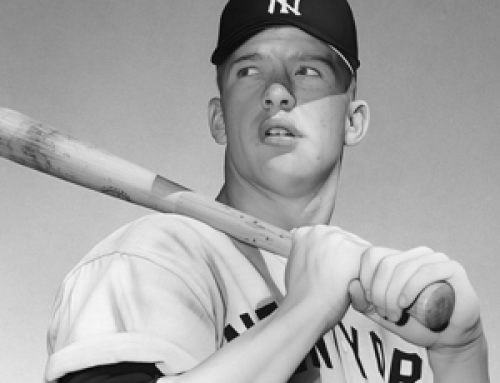Lou Gehrig “The Luckiest Man”
Year – 2012
Size – 30″x43″
Medium – Black & white acrylic paint and colored pencil on gessoed board
SOLD
Port’s exclusive Legendary Icons Series kicked off with this flagship Lou Gehrig piece, “The Luckiest Man.” The Luckiest Man Speech Muscles weakening, joints aching, feet dragging, confidence sagging, the once-mighty Lou Gehrig removed himself from the Yankees lineup card on May 2, 1939, thus ending his epic streak of 2,130 consecutive games. No one knew
what to think—not fans, not reporters, not teammates. Sure, Gehrig looked stiff, wooden almost, when he fielded a grounder, swung a bat or ambled to first. But this was the “Iron Horse,” the heart and soul of the franchise, a diamond superhero who hadn’t taken a day off since 1925. Fourteen years! Now here he was, seated in the dugout as first baseman Babe Dahlgren took the field. Had Gehrig fallen ill? Would he play the next game? Would he ever regain his strength? By mid-June, after medical testing and treatment at the Mayo Clinic, it became clear that baseball was an afterthought—this was a situation of life and death. Gehrig now suffered from the terminal disease of amyotrophic lateral sclerosis, or ALS. Front-page headlines and radio broadcasts dispatched the devastating news to all corners of the country. Americans everywhere entered a state of shock and grief. Ultimately, it was Gehrig himself who would salve the nation’s emotional wound on July 4, 1939, as more than 62,000 supporters filled the rafters at Yankee Stadium and millions more tuned in on the radio dial for Lou Gehrig Appreciation Day. Enfeebled and facing his own mortality, the legend once known as “Larrupin’ Lou” stood near home plate, taking stock of the surrounding figures—past and present teammates, his wife and parents, local politicians—and the gifts arrayed at his feet. With steadfast humility and grace, he choked back tears and mustered the courage to approach the microphone. There he delivered those immortal 13 words, which echoed across the hallowed stadium grounds and have since echoed throughout history as the most inspiring and heartrending words ever uttered in the annals of sport: “Today I consider myself the luckiest man on the face of the earth.” Once again, Lou Gehrig had shown that he was not only the pride of the Yankees, but the pride of America. And, even as his condition worsened to the point that he could no longer walk, the bravery and dignity Gehrig showed in his farewell speech stayed with him until the bitter end, June 2, 1941, when he died of the disease that would one day bear his name.
The Luckiest Man Painting Of all the hundreds of artworks that Adam Port has painted in the past 12 years of his professional career, this monumental and sweeping scene was, according to Port, “by far the most challenging, detailed and labor-intensive project I’ve ever done—requiring more than 200 hours of concentrated effort from start to finish—but also my most enjoyable project.” Unlike a close-up facial rendering, which poses its own unique difficulties but at least centers on one subject, “The Luckiest Man” presented Adam with numerous miniature subjects within the 1,260-square-inch surface, including dozens of small portraits, thousands of distant spectators, an intricate outfield scoreboard, vintage signage and architectural elements. As the focal point, Gehrig alone needed extraordinary attention in order to photorealistically depict his facial features, shadows, uniform folds and pinstripes. Additional facets worth noting are Joe DiMaggio’s presence in the left flank of teammates, and the stadium flagpole strung up with Old Glory above the Yankees’ 1938 world championship flag. “In the first stage of my artistic process, I use graphite pencils to create the under-drawing,” Port explains. “I then begin to paint over that with acrylics. Next, I use various gray-toned colored pencils to render a little more and pull out the highlights. So, I end up going from light to dark and eventually going from dark to light. The last and most rewarding stage comes at the end when I polish up the painting by putting in all the final details.”






